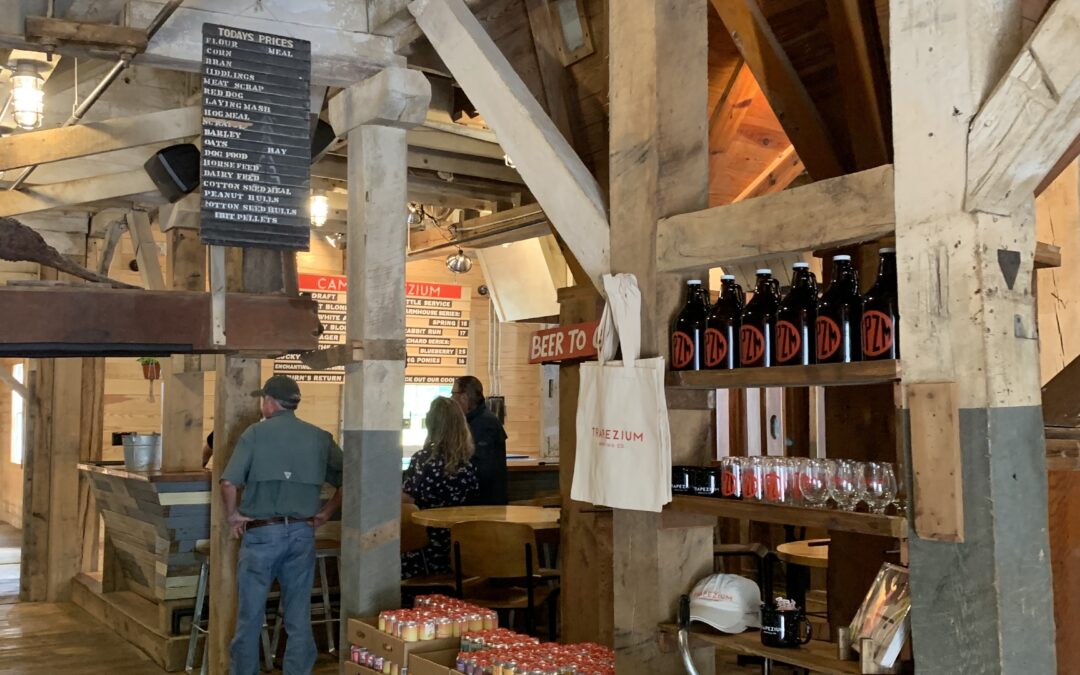(The recently opened Camp Trapezium maintains elements of an 1890 icehouse. Photo by Annie Tobey.)
By Annie Tobey
Beer plays the starring role at a brewery, and taprooms are designed to enhance the experience. In designing the space, brewery owners may consider comfort, aesthetics, branded or quirky décor, and areas for live music and recreation.
A few Virginia breweries have embraced the space by transforming old buildings into memorable digs for sipping modern beer. They have maintained the spirit of the building, accentuating its heritage while welcoming patrons. The websites of some of these breweries even highlight the building’s history.
In some cases, buildout costs make the project seem more like a labor of love than pure practicality. This is especially true for properties listed on the Virginia Landmarks Register or National Register of Historic Places – these renovations may be eligible for grants, but they must also adhere to limits on renovations in order to maintain the historic nature.
Often, craft breweries land in industrial sites, due to zoning laws and equipment needs. Though utilitarian, these buildings can be spruced up to create an eye-catching space, or designers can highlight the old bones of the structure, as with the richly painted exposed brick at Golden Cactus Brewing (Roanoke).
When brewery owners utilize a building that was designed to serve consumers directly – like a store, bank, or house – they have a more picturesque slate to draw upon. The interiors might even be gifted with existing aesthetic elements like decorative ceiling tiles and wooden floors.
Property first
For Dave McCormack of Waukeshaw Development, renovation can be as important to a project as the business that uses the space. Waukeshaw’s portfolio is stocked with historic buildings and difficult renovations in small towns and struggling neighborhoods. McCormack renovates a property, which becomes a new business – breweries, apartments, office space, a bakery, and more.
McCormack’s first renovation-plus-brewery was Trapezium Brewing in 2016. The taproom and production brewery opened in an 1890 icehouse and a renovated coal plant in the Old Towne Petersburg historic district. The next brewery project, Beale’s Beer, opened in Bedford in 2017 in a woolen mill.
The newest Waukeshaw brewery project, Camp Trapezium (Amherst), opened in June 2021 in a circa-1813 gristmill. Challenges arose not only from turning a 200-year-old building into a brewery while meeting government codes but also from adhering to Virginia Department of Historic Resources standards.
“Our goal in renovating was to preserve the unique character of this property, leaving as much of the original materials in place as possible,” says McCormack.
The old mill maintains so much of its original look that a casual passerby may expect to see working farmers pulling up to the covered loading dock. Inside, thick wood beams and wood floors continue the impression, buttressed by milling equipment, industrial cage pendant lighting, a listing of feed prices, and other fitting décor.
In the works for Waukeshaw Development is 93 by Trapezium in a 1927 Masonic lodge in Richmond’s historic Church Hill neighborhood.
Accentuating heritage
Several other Virginia breweries similarly highlight the building as well as the beer.
Long Way Brewing (Radford) shows its reverence for beer in a Seventh Day Adventist church, built in 1950. “The building itself had great bones, original stained-glass windows, hardwood flooring and moldings throughout, and a beautiful stone exterior,” says co-owner Jeff Kleppin. “We wanted to be one of the few breweries in the country that were now operating in an old church. We did some renovations to the inside … [and] rebuilt the altar to accommodate a stage.” The stained-glass window behind the altar needed repair, so they donated it to a local church and replaced it with clear glass for natural lighting. They built an addition to house the brewhouse.
Long Way’s sanctuary taproom reflects its sacred roots, including a lofty ceiling, oak floors, wood trim, stained-glass windows, and pews for seating.
Elkton Brewing Company (Elkton) took over the 1890 Elkton Milling Company building, with a façade fitting the American frontier. “The space has gone through multiple renovations bringing it to its current setup,” explains brewery’s website. “We intentionally preserved and exposed many of the original architectural features, including brick walls, the second-floor beams, and the rare, beautiful, and impressive American Chestnut columns the massive interior chestnut pillars.”
Blue Bee Cider (Richmond) initially opened in the c. 1904 Aragon Coffee building (which now houses the Richmond outpost for Basic City Brewing). In 2016, Blue Bee took possession of Summit Stables, a city-owned property built in the 1940s under the Works Progress Administration to house the mules, carts, and other supplies of the Richmond Public Works Department. Four buildings were constructed using granite cobblestones, probably recycled from city streets, around a central courtyard.
The complex had been neglected for decades, used only as a dumping ground for unused equipment. Fortunately, owner Courtney Mailey appreciated and understood timeworn buildings: she had studied historic preservation at the University of Mary Washington and worked as an administrator for the Virginia Main Street Program. Extensive renovations were guided in part by the site’s historic status and grants.
The picturesque setting is especially appropriate for Blue Bee Cider, which focuses research and production on forgotten heirloom apple varieties.
The Elation Brewing building (Norfolk) began life in 1947 as a Colonial Store, a regional chain grocery store. Having served at least four other uses since then, the structure must have been elated by its most recent use. Owner Kenny VanHook used his background in architecture to renovate the space to be both eye-catching and welcoming. Exposed bowstring trusses and a high arched ceiling give the taproom a spacious feel. VanHook used salvaged materials, including wood from a Suffolk peanut factory for a long, curved bar and materials from a bowling alley and reclaimed beams for tables.
Vanguard Brewery & Distillery (Hampton) filled the Hampton National Guard armory. The 12,000-square-foot building was constructed in 1936 as part of a Works Progress Administration program, using 300,000 red bricks. It was also used as a communal center for Hampton, with a public auditorium, gymnasium, and concert hall. The building was vacated in 1993 and fell into disrepair. It is now listed on the Virginia Landmarks Register and National Register of Historic Places. The Vanguard maintains the building’s industrial look, as in exposed brick walls, while adding aesthetic touches such as white tile behind the bar and copper light fixtures.
The 1906 Elk’s Building that houses Wharf Hill Brewing (Smithfield) might be noteworthy enough on its own, but the renovation and décor present a medley of old repurposed materials. “Every board and nail hole in WHBC is a century old or more and originated from the building itself or some doomed structure nearby,” the website says, “American-made, cut from older, slow-growth trees, and unique to the area (yellow pine!).” The website lists dozens of repurposed items: a bar top made from Elk’s Lodge flooring; bar foot board made from white oak flooring from Slick Nurney’s pig barn; lighting fixtures made from bottles found on site during renovations; pews and chairs from old churches; flooring from Fort Monroe in Hampton; and pressed metal ceiling from Slick Nurney’s house.
Selvedge Brewing (Charlottesville) is woven into The Wool Factory, a complex of industrial buildings that was home to Charlottesville Woolen Mills, founded in 1868 to produce wool textiles, from fabrics for work clothes to cashmeres. Most of the surviving mill buildings standing today were built in 1920s to 1930s. Today, the large redbrick buildings and black trim exude an industrial vibe, while the generous windows lighten the look and the interior. Beer names at Selvedge highlight textile terms, such as Cashmere New England-style DIPA, Corduroy bock, and Seersucker gose. In the tasting room and restaurant, high ceilings, open rafters, and plentiful windows complement the industrial aura.
“The Olde Salem Brewing Company building [Salem] was a multi-use facility built in the ’20s, then an appliance store,” says head brewer Kevin Campbell. Among other renovations, “The original brick was re-exposed [and the] drop ceiling removed,” keeping some of the historical appeal. Olde Salem is adding a satellite location in Roanoke’s Wasena neighborhood, this one in a renovated house.
From Bristol to the beach, these Virginia breweries serve up a taste of the past along with their beer.
Other noteworthy brewery renovations:
Visitors tipping back a pint at these other Virginia breweries can easily imagine the activity that once filled the historic building.
Lake Anne Brew House (Reston) resides in “a mixed-use residential condo in the original historic center of the planned community of Reston, built in 1964,” says co-owner Melissa Berkemeier Romano. “Our specific property was originally designed and constructed to be a one-bedroom condo.” Romano, who is a trained architect, designed a taproom that is both comfortable and stylish, in an apropos mid-century modern theme.
Twin Creeks Brewpub (Roanoke, in Explore Park) makes its home in a restored 200-year-old house and the historic Brugh Tavern. The interior transports visitors back in time, with wide-plank flooring, log cabin walls, and vertical wood panels.
Woodstock Brewhouse (Woodstock) produces beer and entertains visitors in the Casey Jones work clothes factory. Renovations maintained original elements such as 14-foot ceilings and wood flooring.
Bristol Station Brewery & Pub (Bristol) landed in an old Greyhound bus station and Richbrau Brewing (Richmond) in a former auto repair shop.
Reaver Beach Brewing (Norfolk) and Smartmouth Brewing (Virginia Beach) were both destined for post office buildings.
The Bold Mariner Brewing (Norfolk) took over an attractive bank building with a homey wrap-around porch.
State Street Brewing (Bristol) filled a former Hayes Furniture building.
Like Long Way Brewing, Potter’s Craft Cider hosts visitors in an old church building. Cider aficionados commune with the fruit of the apple tree within the stone walls of Neve Hall.
Box Office Brewery (Strasburg) presents its beers in the former c. 1920 Strand Theater, a registered national historic structure. The taproom shows off high ceilings and balcony seating. Whispers of the past replay most clearly in the bre



